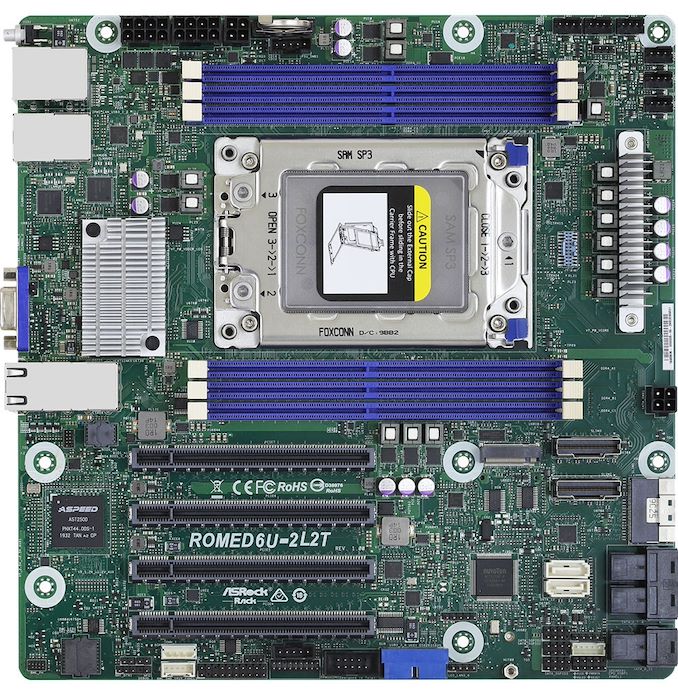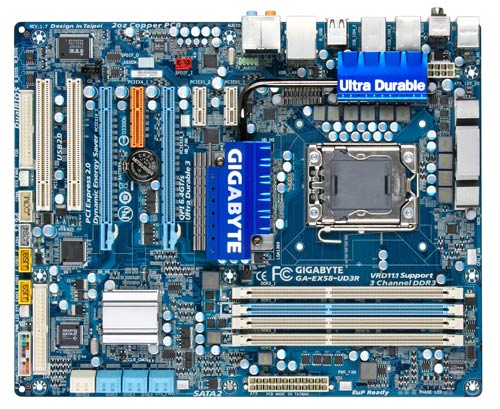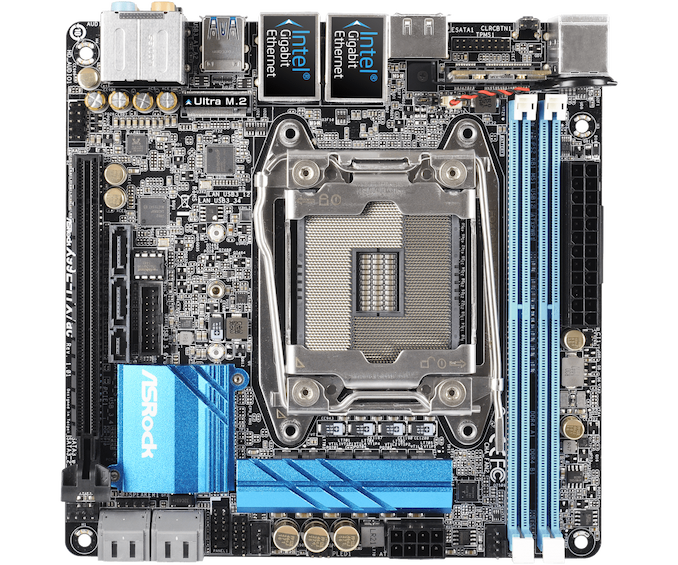ASRock Rack Offers Rome mATX Motherboard with only 6 Memory Channels
by Dr. Ian Cutress on June 8, 2020 8:00 AM EST- Posted in
- Motherboards
- AMD
- ASRock
- ASRock Rack
- EPYC
- Rome
_678x452.jpg)
One of the items that makes a motherboard immediately standout is the amount of memory slots it has. For mainstream platforms, having two or four memory slots, for dual channel memory at one DIMM per channel (1 DPC) or two modules per channel (2 DPC) respectively is normal. If we saw a motherboard with three, it would be a little odd.
We’ve seen high-end desktop platforms have three (Nehalem) or four (almost everything else) memory channels, so we see either 3/4 or 6/8 memory slots respectively for 1 DPC and 2 DPC. When moving into server hardware, Intel’s Xeons have six channels, while AMD’s EPYC has eight channels, so 6/8 and 12/16 for 1 DPC and 2 DPC are obvious.
So what happens when a motherboard displays a different number of memory slots than expected? This is what happens with the new ASRock Rack ROME6U-2L2T motherboard. It supports AMD EPYC processors, both Naples and Rome, which have eight channel memory. Even at 1 module per channel, we expect a minimum of eight memory slots. But for this motherboard, there is only six.
This means that this motherboard, at best, runs in six-channel mode. With a central IO die, like Rome, this means that overall memory bandwidth is reduced by a quarter (or a fourth). For Naples, this gets even weirder, because there is no central IO die, and it means one chiplet out of the four does not have access to memory, similar to how Naples-based Threadripper systems had two chiplets unable to directly access memory.
By why in the world would a motherboard vendor do something like this. It seems counterintuitive, and needlessly hamstrings the processor performance, right?
There are a range of reasons why this is a good idea. For a start, reducing the overall bandwidth (at least, in a Rome CPU) would only affect environments and software setups that are peak memory bandwidth bound. It also reduces the cost of fully populating the system with memory, and it reduces the power consumption enough that perhaps alternative cooling can be considered.
In the situation of this ROME6U-2L2T, the other factor is size. ASRock is putting this big EPYC socket in a micro-ATX form factor, and in order to make the most of the 128 PCIe 4.0 lanes on the motherboard, wanted to put a full x16/x16/x16/x16 layout on the PCIe side. In order to do this, the only way to give enough space for the PCIe slots was to reduce the total amount of memory slots available to the CPU. It’s an interesting tradeoff, likely made at the request of one of ASRock Rack’s customers.
Another angle to consider is a customer with an upgrade path. If a customer is moving from a single socket Xeon platform with six memory channels filled at 1 DPC, then upgrading to AMD with a motherboard that only has six memory slots means the memory can transfer over without any additional cost. This is an outside possibility, but one nonetheless.
As for the motherboard, it actually comes very well equipped. Those four PCIe slots are indeed all PCIe 4.0 x16, and the board has support for 14 SATA ports (12 via mini-SAS), three U.2 ports apparently capable of PCIe 4.0 x8 support, dual 10 gigabit Ethernet ports (10GBase-T via Intel X710-AT2), and two regular gigabit Ethernet ports from Intel i210-AT controllers. Onboard BMC is provided by an ASPEED AST2500, which also has a D-sub 2D video output and a dedicated network interface.
There are also six four-pin fan headers, which is a lot for a board this size (although they’re all in the top right corner), as well as a TPM header, a COM header, a USB 3.0 header, a USB 2.0 header, and USB 3.2 Gen1 ports on the rear.
For motherboards with abnormal configurations, this ROME6U-2L2T isn’t the first. Here’s a look back through a few that I remember.
The GIGABYTE EX58-UD3R was a Nehalem motherboard with a very odd 3+1 configuration, for tri-channel Nehalem processors. This meant that one channel could be substantially bigger than the others, leading to a memory bandwidth imbalance. This was incidentally the first HEDT motherboard I ever owned.
ASRock has form in this game, with the X99E-ITX high-end desktop platform, which should have support for four channel memory. However because of the mini-ITX sized motherboard, and the slim ILM socket being used for the high-end desktop processors, ASRock only put in two DDR3 memory slots on board.
It also came bundled with its own CPU cooler, because ILM coolers weren’t that popular at the time. The reason ASRock went for full-sized memory was unclear, because with the X299E-ITX/ac edition, the same concept was used but with four channels of SO-DIMM. SO-DIMM DDR4 was notoriously hard to source at the time, making the use of the motherboard limited.
You can read our review of the X99E-ITX/ac here!
Finally, another ASRock play – the Xeon Scalable platform has six memory channels, and similar to the previous mini-ITX motherboard, ASRock Rack produced a motherboard with four SO-DIMM slots.
There is literally no space so put six slots on this board. Or so you would think. ASRock also released a six-module version, having to put two of the memory slots on the rear of the mini-ITX motherboard.
As for the ROME6U-2L2T, pricing and exact release date is unknown, as this is officially a product from the ASRock Rack side of the company. Interested parties are instructed to contact their local ASRock server suppliers.
Related Reading
- The ASRock Rack EPYCD8-2T Motherboard Review: From Naples to Rome
- The Supermicro H11DSi Motherboard Mini-Review: The Sole Dual EPYC Solution
- AMD Rome Second Generation EPYC Review: 2x 64-core Benchmarked
- An Interview with AMD’s Forrest Norrod: Naples, Rome, Milan, & Genoa
- The ASRock X99E-ITX/ac Review: Up to 36 Threads in Mini-ITX















27 Comments
View All Comments
Lord of the Bored - Monday, June 8, 2020 - link
Tell ya how I would've done ATX12VO. PCIe power connectors exclusively. Six should cover most use cases, I reckon.Two eight-pin connectors to the motherboard, a third for dedicated CPU power, a six-pin to a "power hub" next to the drive mounts that carries 3v and 5v regulators and a handful of SATA power connectors, and two of whatever is needed by the video card.
Admittedly the power hub is duplicated effort, since the mainboard already needs to generate the lower voltages for fans and PCIe slots and external ports, but I think it is worth it to centralize all drive power in a single off-board location both for cable management and so that can be omitted if unwanted.
bernstein - Tuesday, June 9, 2020 - link
almost all storage servers already employ backplanes that take 12V and convert it to 5V & 3.3V as needed. this makes redundant PSU's as well as power distribution within a server much simpler.also a picopsu style legacy adapter could easily be shipped with any ATX12VO PSU...
bernstein - Monday, June 8, 2020 - link
huh? full atx IS the mainstream platform...also at 6 out of eight memory channels plus ~100 out of 128 pcie lanes this matx board already exposes three thirds of epyc's full IO.
plus i am certain asrockrack could make a similar matx board fully exploiting epyc's IO with just two additional dimm slots and three to four more slimline x8 plugs.
the tricky part would be the power circuitry as the topmost part of the board would be quite packed, but this seems achievable by dropping tow 1GbE sockets with the Intel i210-AT IC giving a more regular 2 10GbE Ethernet capability. Also dropping 6 SATA ports for 3 slimline x8 ports should be relatively easy.
alas thats not what asrockrack's driving customer(s) had in mind and so we get this board.
bernstein - Monday, June 8, 2020 - link
amendment: by today's standards epyc is an IO monster, so exposing 3/4 of epyc's IO is already great!KateNill - Wednesday, June 10, 2020 - link
Visit this site if you are tired of writing challenging assignments. There are much more interesting things to do. Looking for an online helper? No need to rack your brains. Read more about this service.https://writepaperfor.me/do-my-homework
ritawgoodman12 - Thursday, June 18, 2020 - link
Make 6150 bucks every month… Start doing online computer-based work through our website. I have been working from home for 4 years now and I love it. I don’t have a boss standing over my shoulder and I make my own hours. The tips below are very informative and anyone currently working from home or planning to in the future could use this website. WWW.iⅭash68.ⅭOⅯromrunning - Monday, June 8, 2020 - link
I know a lot of the "abnormal" comparisons were about mini-ITX boards, but those changes don't really seem abnormal to me. Mini-ITX has some very specific size constraints, so trade-offs like limiting the DIMM slots to two isn't that uncommon. Although I suppose you could say making a board with four SO-DIMM slots instead of two full-size could be considered abnormal, as that's not the norm for mini-ITX boards.I've purchased several ASRockRack mini-ITX boards for Xeon-based mini-servers that were great for portability. I used them for work at expos where their footprint was small enough to house two servers in the area where usually only one server would fit, which then gave me the redundant servers I needed. So for that purpose, I appreciate ASRockRack making some boards in small form factors like mini-ITX that can shoehorn some large CPUs on them. The power & portability was definitely a win for my use-case.
eastcoast_pete - Monday, June 8, 2020 - link
How much space is allowed between the PCIe 4.0 slots? It looks to be a "normal" amount, but hard to tell from a picture. The reason why I ask is another use scenario, in which the availability of multiple PCI 4.0 connections outweighs the downside of only having 6 memory slots.DanNeely - Monday, June 8, 2020 - link
I'm really curious where this board is going. It's not just the ram configuration being weird enough to probably turn most customers off; but it doesn't have a standard power hookup. No conventional 24pin ATX plug, and no next generation10pin ATX12VO plug either.bernstein - Monday, June 8, 2020 - link
looks like one of the ATX12VO boards. yay! now we just need nice compact ATX12VO PSU's...